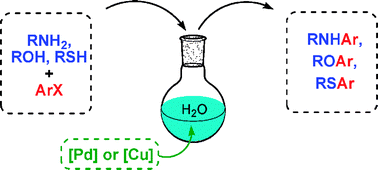Palladium and copper-catalysed arylation reactions in the presence of water, with a focus on carbon–heteroatom bond formation†
Abstract
Palladium and copper-catalysed

* Corresponding authors
a
Zientzia eta Teknologia Fakultatea, Euskal Herriko Unibertsitatea, P.O. Box 644, Bilbao, Spain
E-mail:
raul.sanmartin@ehu.es
Fax: (+ 34) 94 601 27 48
Tel: (+ 34) 94 601 54 35
Palladium and copper-catalysed

 Please wait while we load your content...
Something went wrong. Try again?
Please wait while we load your content...
Something went wrong. Try again?
M. Carril, R. SanMartin and E. Domínguez, Chem. Soc. Rev., 2008, 37, 639 DOI: 10.1039/B709565C
To request permission to reproduce material from this article, please go to the Copyright Clearance Center request page.
If you are an author contributing to an RSC publication, you do not need to request permission provided correct acknowledgement is given.
If you are the author of this article, you do not need to request permission to reproduce figures and diagrams provided correct acknowledgement is given. If you want to reproduce the whole article in a third-party publication (excluding your thesis/dissertation for which permission is not required) please go to the Copyright Clearance Center request page.
Read more about how to correctly acknowledge RSC content.
 Fetching data from CrossRef.
Fetching data from CrossRef.
This may take some time to load.
Loading related content
